cruise control OPEL VIVARO C 2020.25 Manual user
[x] Cancel search | Manufacturer: OPEL, Model Year: 2020.25, Model line: VIVARO C, Model: OPEL VIVARO C 2020.25Pages: 287, PDF Size: 28.79 MB
Page 177 of 287
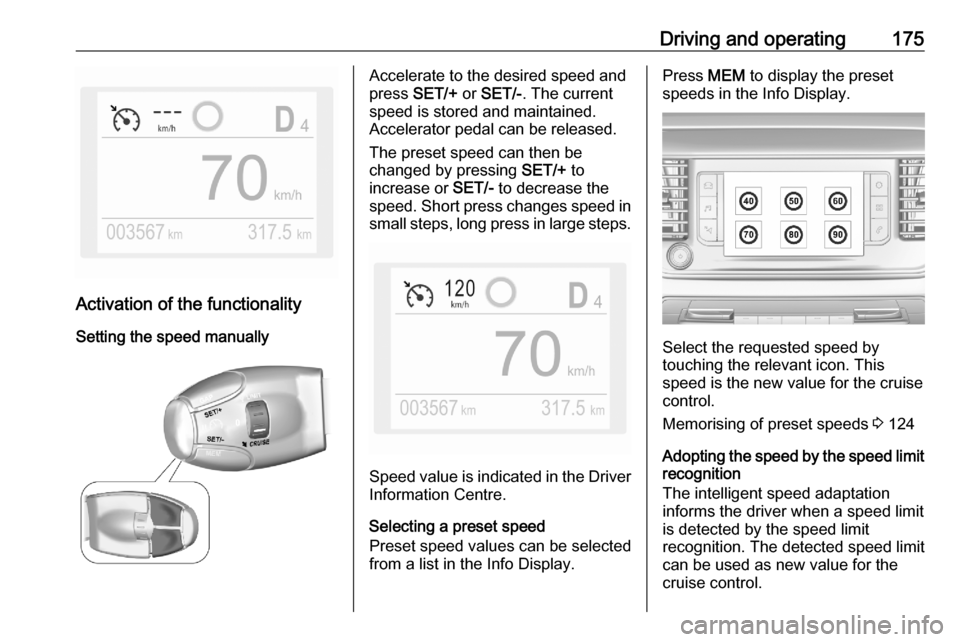
Driving and operating175
Activation of the functionalitySetting the speed manually
Accelerate to the desired speed and
press SET/+ or SET/- . The current
speed is stored and maintained.
Accelerator pedal can be released.
The preset speed can then be
changed by pressing SET/+ to
increase or SET/- to decrease the
speed. Short press changes speed in small steps, long press in large steps.
Speed value is indicated in the Driver
Information Centre.
Selecting a preset speed
Preset speed values can be selected
from a list in the Info Display.
Press MEM to display the preset
speeds in the Info Display.
Select the requested speed by
touching the relevant icon. This
speed is the new value for the cruise
control.
Memorising of preset speeds 3 124
Adopting the speed by the speed limit recognition
The intelligent speed adaptation
informs the driver when a speed limit
is detected by the speed limit
recognition. The detected speed limit
can be used as new value for the
cruise control.
Page 178 of 287
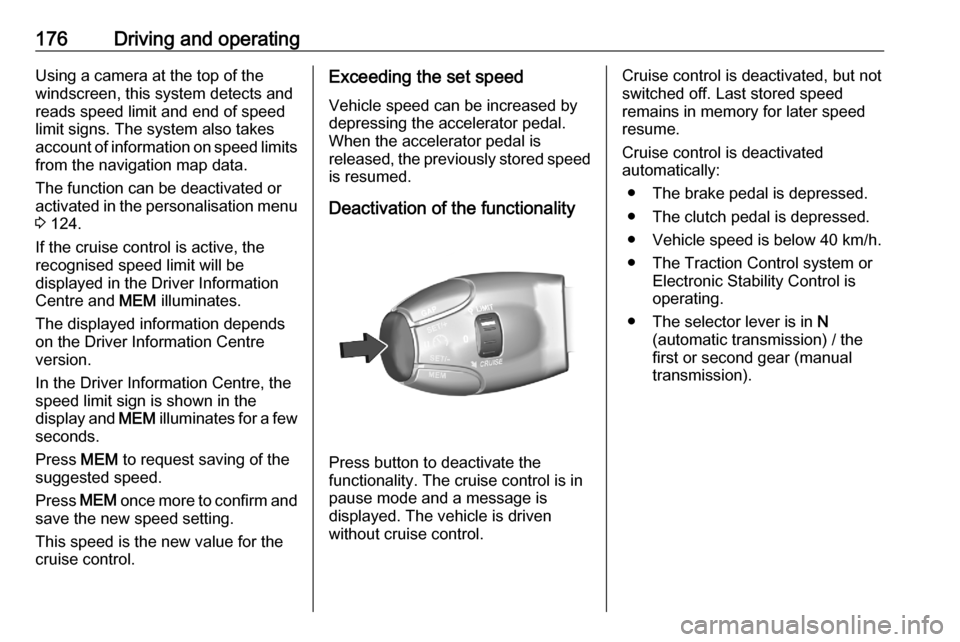
176Driving and operatingUsing a camera at the top of the
windscreen, this system detects and
reads speed limit and end of speed
limit signs. The system also takes
account of information on speed limits from the navigation map data.
The function can be deactivated or
activated in the personalisation menu
3 124.
If the cruise control is active, the
recognised speed limit will be
displayed in the Driver Information
Centre and MEM illuminates.
The displayed information depends
on the Driver Information Centre
version.
In the Driver Information Centre, the
speed limit sign is shown in the
display and MEM illuminates for a few
seconds.
Press MEM to request saving of the
suggested speed.
Press MEM once more to confirm and
save the new speed setting.
This speed is the new value for the
cruise control.Exceeding the set speed
Vehicle speed can be increased by
depressing the accelerator pedal.
When the accelerator pedal is
released, the previously stored speed
is resumed.
Deactivation of the functionality
Press button to deactivate the
functionality. The cruise control is in
pause mode and a message is
displayed. The vehicle is driven
without cruise control.
Cruise control is deactivated, but not
switched off. Last stored speed
remains in memory for later speed
resume.
Cruise control is deactivated
automatically:
● The brake pedal is depressed.
● The clutch pedal is depressed.
● Vehicle speed is below 40 km/h.
● The Traction Control system or Electronic Stability Control is
operating.
● The selector lever is in N
(automatic transmission) / the first or second gear (manual
transmission).
Page 179 of 287
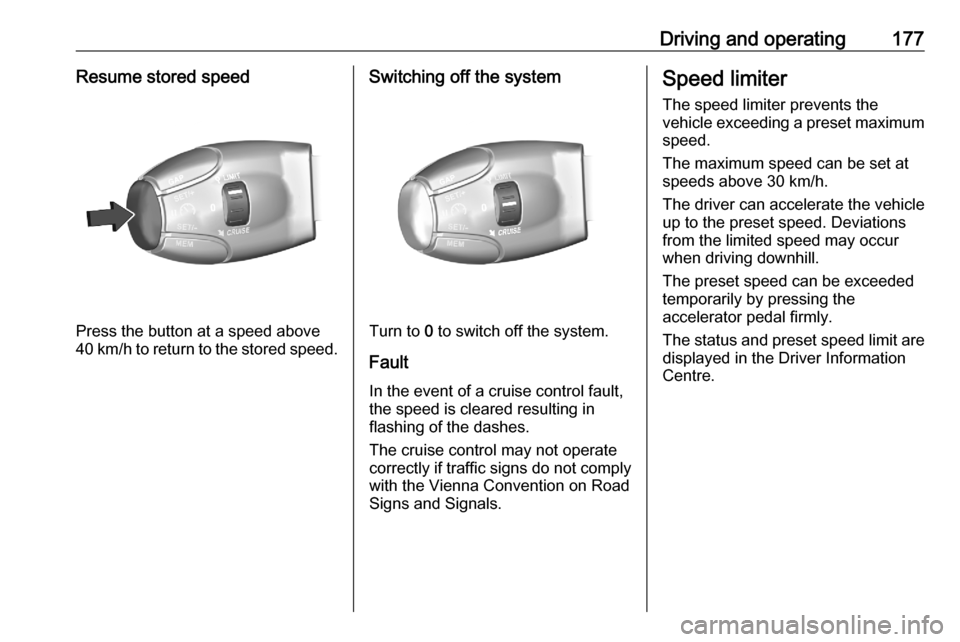
Driving and operating177Resume stored speed
Press the button at a speed above
40 km/h to return to the stored speed.
Switching off the system
Turn to 0 to switch off the system.
Fault
In the event of a cruise control fault, the speed is cleared resulting in
flashing of the dashes.
The cruise control may not operate
correctly if traffic signs do not comply with the Vienna Convention on Road
Signs and Signals.
Speed limiter
The speed limiter prevents the
vehicle exceeding a preset maximum speed.
The maximum speed can be set at
speeds above 30 km/h.
The driver can accelerate the vehicle
up to the preset speed. Deviations
from the limited speed may occur
when driving downhill.
The preset speed can be exceeded
temporarily by pressing the
accelerator pedal firmly.
The status and preset speed limit are
displayed in the Driver Information
Centre.
Page 182 of 287

180Driving and operatingThe speed limiter is deactivated, but
not switched off. The last stored
speed remains in memory for later
speed resume.
Resume limit speed
Press the button to return to the
stored speed limit.
Switching off the system
Turn to 0 to switch off the system.
Fault
In the event of a speed limiter fault, the speed is cleared resulting in
flashing of the dashes.
The speed limiter may not operate
correctly if traffic signs do not comply with the Vienna Convention on Road
Signs and Signals.
Adaptive cruise control
The adaptive cruise control is an
enhancement to the conventional
cruise control with the additional
feature of maintaining a certain
following distance to the vehicle
ahead. It uses a camera at the top of
the windscreen and a radar sensor in
the front bumper to detect the
vehicles ahead. If no vehicle is
detected in the driving path, the
adaptive cruise control will behave
like a conventional cruise control.
The adaptive cruise control
automatically decelerates the vehicle
when approaching a slower moving
vehicle. It then adjusts the vehicle
speed to follow the vehicle ahead at
the selected following distance. The
vehicle speed increases or decreases
to follow the vehicle ahead, but will
not exceed the set speed. The
adaptive cruise control does not
actively brake the vehicle but uses
engine braking.
If the vehicle ahead accelerates or changes lane, the adaptive cruise
control progressively accelerates the
vehicle to return to the stored set
Page 183 of 287
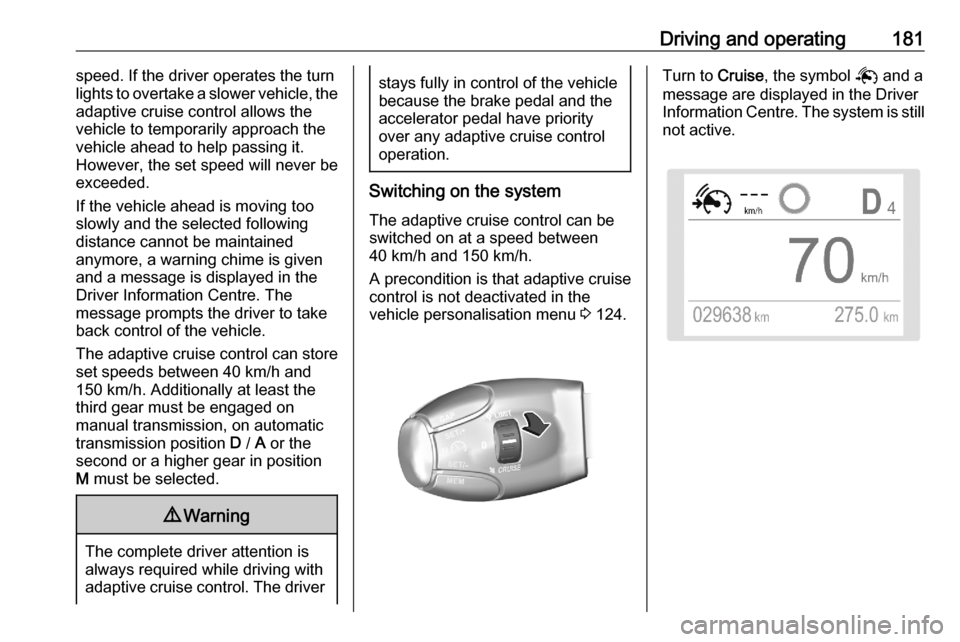
Driving and operating181speed. If the driver operates the turn
lights to overtake a slower vehicle, the
adaptive cruise control allows the
vehicle to temporarily approach the
vehicle ahead to help passing it.
However, the set speed will never be
exceeded.
If the vehicle ahead is moving too
slowly and the selected following
distance cannot be maintained
anymore, a warning chime is given
and a message is displayed in the
Driver Information Centre. The
message prompts the driver to take
back control of the vehicle.
The adaptive cruise control can store set speeds between 40 km/h and
150 km/h. Additionally at least the
third gear must be engaged on
manual transmission, on automatic
transmission position D / A or the
second or a higher gear in position
M must be selected.9 Warning
The complete driver attention is
always required while driving with adaptive cruise control. The driver
stays fully in control of the vehicle
because the brake pedal and the accelerator pedal have priority
over any adaptive cruise control operation.
Switching on the system
The adaptive cruise control can be
switched on at a speed between
40 km/h and 150 km/h.
A precondition is that adaptive cruise
control is not deactivated in the
vehicle personalisation menu 3 124.
Turn to Cruise, the symbol Q and a
message are displayed in the Driver Information Centre. The system is still not active.
Page 184 of 287
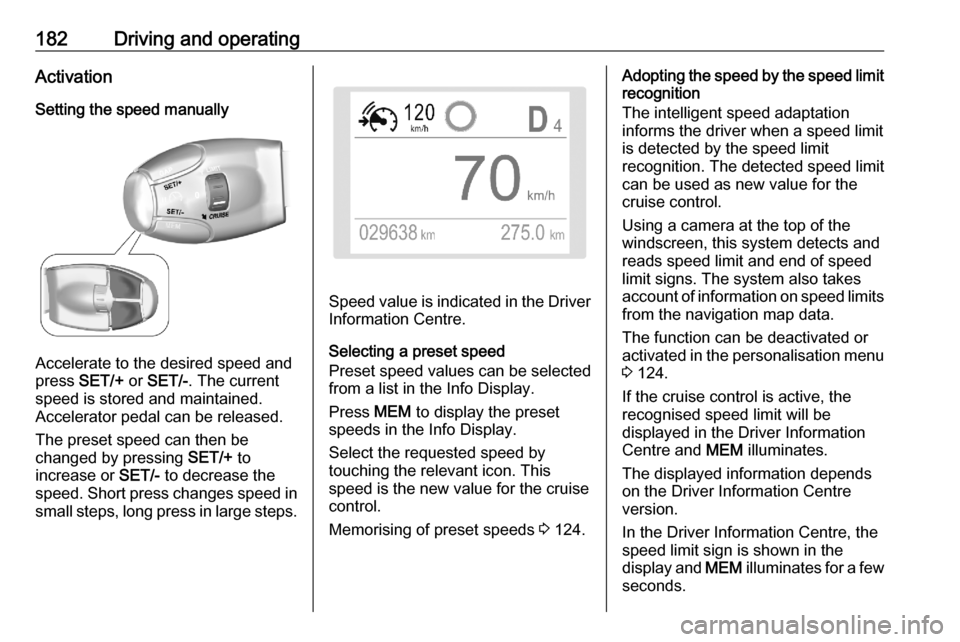
182Driving and operatingActivation
Setting the speed manually
Accelerate to the desired speed and
press SET/+ or SET/- . The current
speed is stored and maintained.
Accelerator pedal can be released.
The preset speed can then be
changed by pressing SET/+ to
increase or SET/- to decrease the
speed. Short press changes speed in small steps, long press in large steps.
Speed value is indicated in the Driver Information Centre.
Selecting a preset speed
Preset speed values can be selected
from a list in the Info Display.
Press MEM to display the preset
speeds in the Info Display.
Select the requested speed by
touching the relevant icon. This
speed is the new value for the cruise
control.
Memorising of preset speeds 3 124.
Adopting the speed by the speed limit
recognition
The intelligent speed adaptation
informs the driver when a speed limit
is detected by the speed limit
recognition. The detected speed limit
can be used as new value for the
cruise control.
Using a camera at the top of the windscreen, this system detects and
reads speed limit and end of speed
limit signs. The system also takes
account of information on speed limits from the navigation map data.
The function can be deactivated or
activated in the personalisation menu
3 124.
If the cruise control is active, the
recognised speed limit will be
displayed in the Driver Information
Centre and MEM illuminates.
The displayed information depends
on the Driver Information Centre
version.
In the Driver Information Centre, the
speed limit sign is shown in the
display and MEM illuminates for a few
seconds.
Page 185 of 287

Driving and operating183Press MEM to request saving of the
suggested speed.
Press MEM once more to confirm and
save the new speed setting.
This speed is the new value for the
cruise control.
Exceeding the set speed
Vehicle speed can be increased by depressing the accelerator pedal.
When the accelerator pedal is
released, the previously stored speed
is resumed. If a slower moving vehicle is ahead, the following distance
selected by the driver is restored.
If the set speed is exceeded, the
indicated speed setting flashes in the Driver Information Centre and a
warning message appears.Resume stored speed
Press the button at a speed above
40 km/h to return to the stored speed.
Setting the following distance
When adaptive cruise control detects a slower moving vehicle in the drivingpath, it will adjust the vehicle speed to
maintain the following distance
selected by the driver.
The following distance can be set to
close (1 bar), normal (2 bars) or far
(3 bars).
If the engine is running and the
adaptive cruise control is enabled
(grey), you can modify the following
distance setting:
Press GAP, the current setting is
shown in the Driver Information
Centre.
Press GAP again to change the
following distance: The new setting is displayed in the Driver Information
Centre.
The selected following distance is
indicated by full bars in the adaptive
cruise control page.9 Warning
The driver accepts full
responsibility for the appropriate
following distance based on traffic, weather and visibility conditions.
Following distance must be
adjusted or the system switched
off when required by the prevailing
conditions.
Page 186 of 287

184Driving and operatingDetecting the vehicle ahead
If the system does not detect a vehicle in the driving path, U is displayed
in the Driver Information Centre. The
system operates as conventional
cruise control.
If the system detects a vehicle in the
driving path, V is displayed in the
Driver Information Centre. The
system operates as conventional
cruise control.
If the system detects a vehicle in the
driving path which is too close or too
slow, it adjusts the speed accordingly. X is displayed in the Driver
Information Centre.
If the system reaches the limit of
adjusting the speed and the driver
does not react to this situation, the
system is automatically deactivated
and W is displayed in the Driver
Information Centre.
If the set speed is temporarily
exceeded by the driver, the system is automatically deactivated and Z is
displayed in the Driver Information
Centre.Deactivation of the functionality
Press button to deactivate the
functionality. The cruise control is in
pause mode and a message is
displayed. The vehicle is driven
without cruise control.
Cruise control is deactivated, but not
switched off. Last stored speed
remains in memory for later speed
resume.
Cruise control is deactivated
automatically:
● maximum deviation of 30 km/h between set speed and speed of
the vehicle ahead reached
● distance between vehicle and vehicle ahead too small
● vehicle speed below 40 km/h
● speed of the vehicle ahead too slow
● Traction Control system or Electronic Stability Control
operating
● selected following distance reached
● another vehicle inserts between vehicle and vehicle ahead
● following distance cannot be maintained, e.g., in the case of a
steep descent
Page 187 of 287

Driving and operating185Switching off the system
Turn to 0 to switch off the system. The
symbol 5 and a message are
displayed in the Driver Information
Centre.
Switching off the ignition deletes the
stored set speed.
Driver's attention ● Use the adaptive cruise control carefully on bends or mountain
roads, as it can lose the vehicle
ahead and needs time to detect it again.
● Do not use the system on slippery roads as it can create
rapid changes in tyre traction
(wheel spinning), so that the
control of the vehicle can be lost.
● Do not use the system when the spare wheel is in use.
System limits9 Warning
The system's automatic brake
force does not permit hard braking and the braking level may not be
sufficient to avoid a collision.
● The control range is limited to a maximum deviation of 30 km/h
between the set speed and the
speed of the vehicle ahead.
● After a sudden lane change, the system needs a certain time to
detect the next preceding
vehicle. So if a new vehicle is
detected, the system may
accelerate instead of braking.
● The adaptive cruise control does ignore the oncoming traffic.
● The adaptive cruise control does not consider pedestrians and
animals for braking and driving
off.
● The adaptive cruise control considers stopped vehicles onlyat low speed.
● Do not use the adaptive cruise control when towing a trailer.
● Do not use the adaptive cruise control on roads with an incline ofmore than 10%.
Bends
The adaptive cruise control calculates
a predicted path based on the
centrifugal force. This predicted path
considers the current bend
characteristic, but cannot consider a
future bend change. The system may lose the current vehicle ahead or
consider a vehicle which is not in the
Page 188 of 287
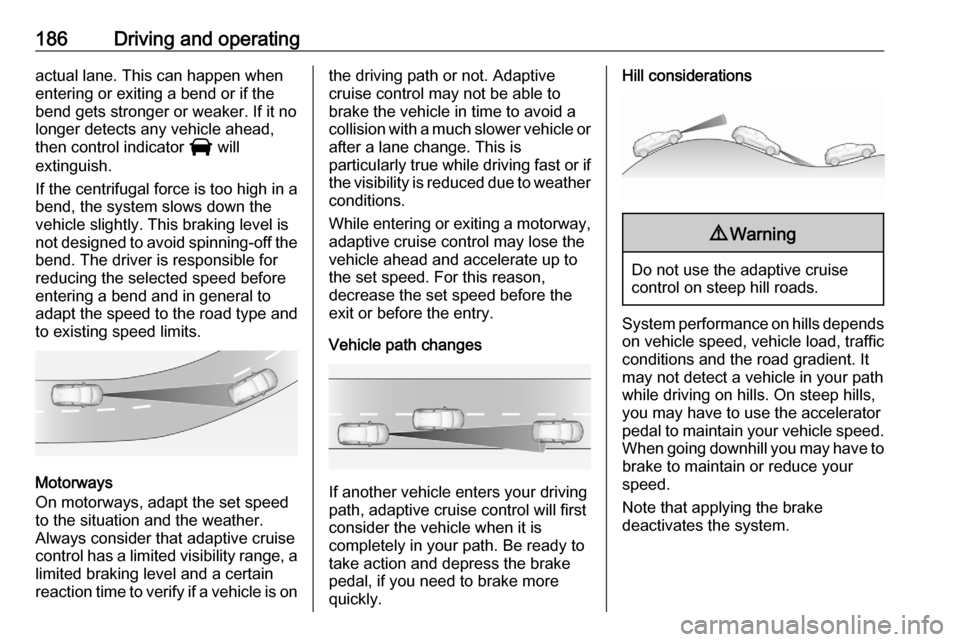
186Driving and operatingactual lane. This can happen when
entering or exiting a bend or if the
bend gets stronger or weaker. If it no
longer detects any vehicle ahead,
then control indicator I will
extinguish.
If the centrifugal force is too high in a
bend, the system slows down the
vehicle slightly. This braking level is
not designed to avoid spinning-off the
bend. The driver is responsible for
reducing the selected speed before
entering a bend and in general to
adapt the speed to the road type and
to existing speed limits.
Motorways
On motorways, adapt the set speed
to the situation and the weather.
Always consider that adaptive cruise
control has a limited visibility range, a
limited braking level and a certain
reaction time to verify if a vehicle is on
the driving path or not. Adaptive
cruise control may not be able to
brake the vehicle in time to avoid a
collision with a much slower vehicle or after a lane change. This is
particularly true while driving fast or if the visibility is reduced due to weather
conditions.
While entering or exiting a motorway,
adaptive cruise control may lose the
vehicle ahead and accelerate up to
the set speed. For this reason,
decrease the set speed before the
exit or before the entry.
Vehicle path changes
If another vehicle enters your driving
path, adaptive cruise control will first
consider the vehicle when it is
completely in your path. Be ready to
take action and depress the brake
pedal, if you need to brake more
quickly.
Hill considerations9 Warning
Do not use the adaptive cruise
control on steep hill roads.
System performance on hills depends
on vehicle speed, vehicle load, traffic
conditions and the road gradient. It
may not detect a vehicle in your path
while driving on hills. On steep hills,
you may have to use the accelerator
pedal to maintain your vehicle speed.
When going downhill you may have to brake to maintain or reduce your
speed.
Note that applying the brake
deactivates the system.